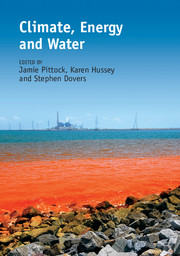Book contents
- Frontmatter
- Contents
- List of contributors
- Acknowledgements
- 1 Justifying, extending and applying “nexus” thinking in the quest for sustainable development
- 2 Water resources, climate change and energy
- 3 Implications of climate change for energy systems in a multisectoral context
- 4 Fossil fuels and water: A complex and evolving relationship
- 5 Renewable energy and water
- 6 Hydropower within the climate, energy and water nexus
- 7 Water and biofuels
- 8 Trade-offs and synergies between water and energy use in rural Australia
- 9 Management of the urban energy-water nexus
- 10 Managing the electricity-water nexus in China, France, India and the United States
- 11 Cross-sectoral governance of the climate, energy and water sectors: A ‘Rubik's cube’ analysis of cross-sectoral co-ordination
- 12 Regulation of the nexus
- 13 Climate, energy and water: the potential roles and limitations of markets
- 14 Strategies to mainstream climate change, energy, water and food security nexus knowledge and skills
- 15 A nexus of nexuses: systemic governance for climate response
- 16 Integrated modelling of the energy-water nexus in the American West
- 17 Biodiversity and the climate, energy and water nexus
- 18 Consumers, food supply chain and the nexus
- 19 Future prospects in climate, energy and water research and policy
- Index
17 - Biodiversity and the climate, energy and water nexus
Published online by Cambridge University Press: 05 April 2015
- Frontmatter
- Contents
- List of contributors
- Acknowledgements
- 1 Justifying, extending and applying “nexus” thinking in the quest for sustainable development
- 2 Water resources, climate change and energy
- 3 Implications of climate change for energy systems in a multisectoral context
- 4 Fossil fuels and water: A complex and evolving relationship
- 5 Renewable energy and water
- 6 Hydropower within the climate, energy and water nexus
- 7 Water and biofuels
- 8 Trade-offs and synergies between water and energy use in rural Australia
- 9 Management of the urban energy-water nexus
- 10 Managing the electricity-water nexus in China, France, India and the United States
- 11 Cross-sectoral governance of the climate, energy and water sectors: A ‘Rubik's cube’ analysis of cross-sectoral co-ordination
- 12 Regulation of the nexus
- 13 Climate, energy and water: the potential roles and limitations of markets
- 14 Strategies to mainstream climate change, energy, water and food security nexus knowledge and skills
- 15 A nexus of nexuses: systemic governance for climate response
- 16 Integrated modelling of the energy-water nexus in the American West
- 17 Biodiversity and the climate, energy and water nexus
- 18 Consumers, food supply chain and the nexus
- 19 Future prospects in climate, energy and water research and policy
- Index
Summary
Introduction
Climate change driven by the use of carbon-intensive energy is a proposed planetary boundary: a threshold that demarcates a safe living space for humanity (Rockström et al. 2009). Two other planetary boundaries are water consumption and biodiversity loss (Rockström et al. 2009).
The extensive loss of biodiversity impacts on humanity in two main ways. First, ecosystems provide humanity with a range of services, namely provisioning services such as fish and clean water, regulating services such as clean air and flood mitigation, cultural services such as recreational opportunities and spiritual succour, and supporting services like soil formation (UNEP 2007). Second, many argue that humanity has a moral imperative to conserve the diversity of life. This concern for biodiversity conservation has been codified by our national governments in international law, as discussed further in this chapter.
Demands to supply energy with lower carbon emissions and to secure water supplies under a changing climate are driving rapid decision making and deployment of new technologies, or old technologies at a greater scale than before, risking perverse outcomes (Pittock et al. 2013). In this volume, key aspects of the linkages between climate, energy and water are discussed, with a view to identifying management interventions by which positive interactions may be favoured and perverse impacts avoided. This chapter examines how management of the links between climate, energy and water can hinder or help progress in another sector, the conservation of biodiversity. This discussion begins with an overview of the conservation of biodiversity and a summary of the impacts of water use and energy supply on biodiversity.
Biodiversity conservation
The Millennium Ecosystem Assessment attributes the major causes of biodiversity loss as being driven by infrastructure development, land (habitat) conversion, pollution, over-harvesting and overexploitation, the introduction of invasive species and global climate change (MEA 2005a). The drivers of biodiversity loss have cumulative impacts and are likely to be exacerbated by climate change.
- Type
- Chapter
- Information
- Climate, Energy and Water , pp. 283 - 302Publisher: Cambridge University PressPrint publication year: 2015
- 3
- Cited by



